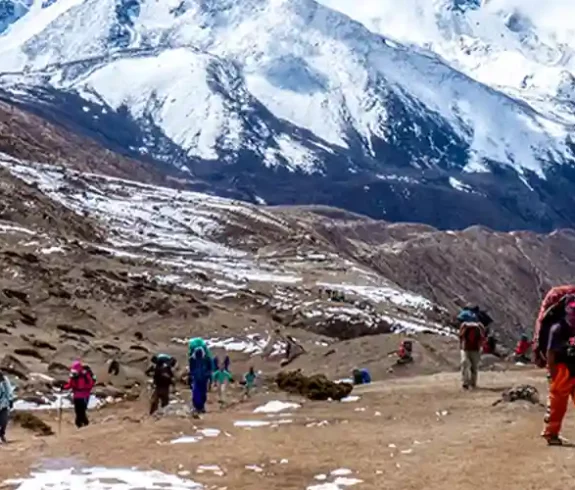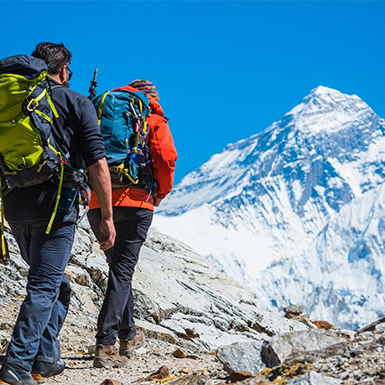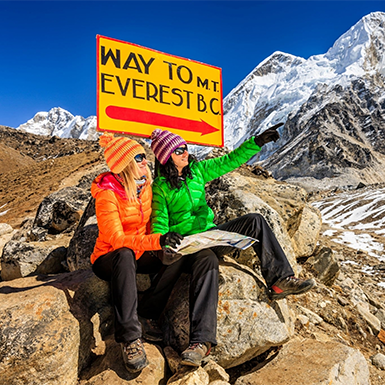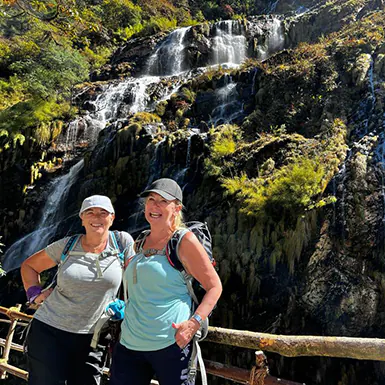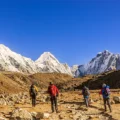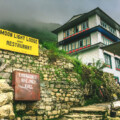Nestled in the heart of the Khumbu region, Dingboche Nepal is a picturesque Sherpa village that captures trekkers with its rugged charm and stunning Himalayan vistas. This high-altitude haven, situated at 4,410 meters (14,469 feet), is a crucial acclimatization stop for those heading to the iconic Everest Base Camp trek.
Dingboche, Nepal, is not merely a resting point; it’s an integral part of the Everest trekking experience. Its strategic location allows trekkers to adjust to the increasing altitude gradually, minimizing the risk of altitude sickness. The village offers breathtaking panoramic views of Ama Dablam, Lhotse, and Island Peak, making it a photographer’s paradise.
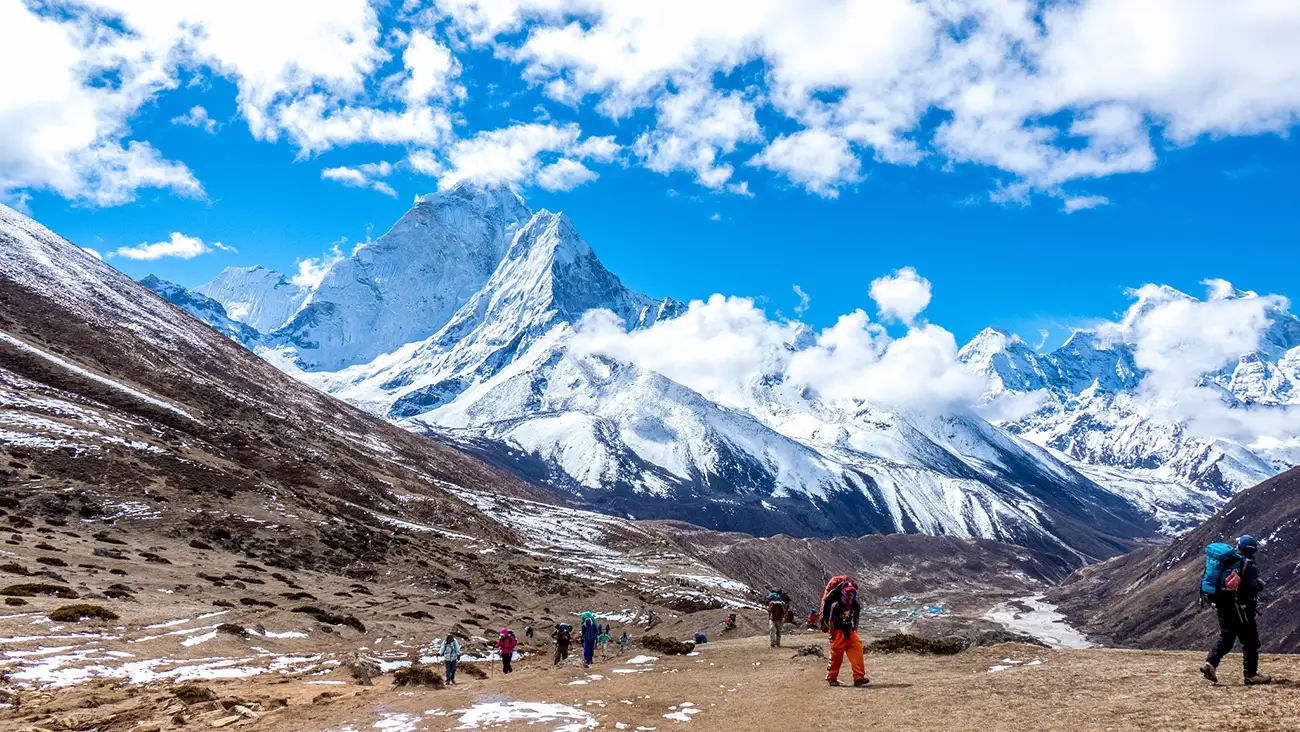
Dingboche’s Strategic Significance on the Everest Trek
Dingboche Nepal plays a pivotal role in the Everest trekking route, offering trekkers a vital opportunity to acclimatize to the increasing altitude. It is a popular stopover point for those ascending to Everest Base Camp and those exploring the scenic trails leading to other notable regional destinations. The village’s strategic location, stunning natural beauty, and cultural significance make it integral to any Everest adventure.
- Acclimatization: Acclimatization is easier in Dingboche due to its elevation, making the trek safer and more enjoyable.
- Scenic Beauty: From the village, photographers will be in awe of the breathtaking vistas of Ama Dablam, Lhotse, and Island Peak.
- Cultural Immersion: Dingboche is home to the Sherpa people, with a rich cultural heritage and warm hospitality. Visitors can explore Buddhist monasteries, interact with locals, and gain insights into their traditions.
- Rest and Recuperation: Dingboche’s numerous teahouses and lodges provide the perfect place for trekkers to unwind with delicious food before continuing their trek.
- Trail Junction: Dingboche serves as a trail junction, offering trekkers various routes to explore, including the Everest Base Camp trail, the Three Passes trek, and the trek to Island Peak.
Geographical Gem in the Himalayas
Dingboche, a charming Khumbu village, is a popular Everest Base Camp trek stop. Its strategic location amidst towering peaks and serene valleys makes it a geographical gem in the Himalayas.
Dingboche’s Location in Nepal
Dingboche lies within the Sagarmatha National Park, a UNESCO World Heritage site celebrated for its biodiversity and breathtaking landscapes. The village sits 4,410 meters (14,469 feet) above sea level, making the Dingboche elevation a crucial factor in acclimatization for trekkers.
Dingboche village is accessible via well-trodden trails that wind through lush rhododendron forests and alongside the Imja Khola River. The trek typically begins in Namche Bazaar and takes trekkers through Tengboche, another significant Everest Base Camp route stop. The Tengboche to Dingboche distance covers approximately 8 kilometers (5 miles) and usually takes 4-5 hours.

Proximity to Mount Everest and Other Landmarks
Dingboche’s strategic location offers trekkers stunning panoramic views of some of the world’s highest peaks. To the north, the majestic Mount Everest dominates the skyline, while Ama Dablam, Lhotse, and Island Peak grace the surrounding landscape. The proximity to these iconic landmarks makes Dingboche a photographer’s paradise and a haven for mountaineering enthusiasts.
The village serves as a base for several acclimatization hikes, including a day trip to Nagarjun Hill, which offers unparalleled views of the Himalayan panorama. From Dingboche, the trek continues towards Lobuche, the next major stop at Everest Base Camp. The distance from Dingboche to Lobuche is around 10 kilometers (6.2 miles) and usually takes 5-6 hours.
Dingboche Elevation and Altitude: Acclimatization and Himalayan Views
The captivating village of Dingboche Nepal, is renowned for its stunning Himalayan vistas and crucial role in the Everest Base Camp trek. The Dingboche elevation and altitude significantly shape the trekking experience.
Dingboche Elevation: A High-Altitude Haven
Dingboche is at a lofty elevation of 4,410 meters (14,470 feet) above sea level, making it a high-altitude haven for trekkers. The village is strategically situated along the Everest Base Camp trail, providing a vital acclimatization stop for those ascending to higher altitudes.
The Significance of Dingboche Altitude
The high Dingboche altitude presents both challenges and rewards for trekkers. Acclimatize carefully to prevent altitude sickness at this high elevation. Therefore, spending a few days in Dingboche is essential for allowing the body to adjust to the reduced oxygen levels.
During acclimatization, trekkers can explore the picturesque Dingboche village and its surroundings. Day hikes to Nagarjun Hill or Chukkung Ri offer breathtaking panoramic views of the Himalayas and further aid in acclimatization.
Impact on Trekkers
High altitude can affect trekkers in several ways, with common symptoms such as headaches, nausea, fatigue, and shortness of breath. Staying hydrated, eating well, and listening to your body are essential during acclimatization.
The Dingboche weather can also be challenging, with cold temperatures and unpredictable conditions. Trekkers should prepare for snow, wind, and rapid weather changes, especially during winter.

Dingboche Nepal: Trekking Routes and Distances
Navigating the trails around Dingboche, Nepal, offers trekkers a diverse experience, from challenging ascents to serene valley walks. Understanding the routes and distances is essential for planning your trekking adventure.
Dingboche to Lobuche: A Scenic Himalayan Trek
The trek from Dingboche to Lobuche is scenic and passes through the heart of the Khumbu region. The 10-kilometer trek to Everest Base Camp offers diverse landscapes, from rocky moraines to glacial valleys.
- Distance: The distance from Dingboche to Lobuche is approximately 10 kilometers (6.2 miles), offering trekkers a moderate day’s hike.
- Estimated Trekking Time: Most trekkers complete this section in about 5-6 hours, depending on their pace and fitness level.
- Trail Conditions: The trail ascends gradually at first, passing through yak pastures and summer settlements. As you gain altitude, the terrain becomes rockier, with occasional steep sections.
- Scenery: The trek rewards hikers with breathtaking panoramas of iconic peaks like Ama Dablam, Lhotse, and Nuptse.
- Altitude Considerations: The Dingboche altitude is 4,410 meters (14,470 feet), and the Lobuche altitude is 4,940 meters (16,207 feet). The gradual ascent helps with acclimatization, but monitoring for any signs of altitude sickness is essential.
Tengboche to Dingboche: A Scenic Himalayan Passage
The trek from Tengboche to Dingboche unveils a picturesque passage through the heart of the Khumbu region. Traversing approximately 9 kilometers (5.6 miles), this leg of the Everest Base Camp trail presents trekkers with diverse landscapes, including lush rhododendron forests, rocky paths, and breathtaking views of the Himalayan giants.
- Distance: The Tengboche to Dingboche distance stretches roughly 9 kilometers (5.6 miles), constituting a moderate day’s hike.
- Estimated Trekking Time: Most trekkers complete this segment in about 4-5 hours, contingent upon their pace and physical condition.
- Trail Conditions: The trail initially descends from Tengboche, crossing the Imja Khola River, before ascending gradually towards Dingboche. It meanders through forests and open landscapes, offering varied terrain and scenic vistas.
- Scenic Highlights: The trek rewards trekkers with mesmerizing views of Ama Dablam, Lhotse, and other towering peaks. The trail also passes through traditional Sherpa villages, providing glimpses into the local culture and lifestyle.
- Altitude Considerations: The Tengboche altitude is 3,867 meters (12,687 feet), while the Dingboche altitude is 4,410 meters (14,469 feet). This ascent contributes to acclimatization, but trekkers should remain mindful of any signs of altitude sickness.
Dingboche to Everest Base Camp: A Challenging Yet Rewarding Trek
The trek from Dingboche to Everest Base Camp is the pinnacle of the trek, offering trekkers a challenging yet rewarding experience amidst the awe-inspiring Himalayas. Spanning approximately 15 kilometers (9.3 miles), this leg of the trek takes you through diverse terrain, from rocky moraines to glacial valleys.
- Distance: The distance from Dingboche to Everest Base Camp is roughly 15 kilometers (9.3 miles), which makes it a demanding day’s trek.
- Estimated Trekking Time: Most trekkers complete this segment in about 6-8 hours, contingent upon their pace and physical condition.
- Trail Conditions: The trail ascends gradually at first, passing through the village of Duglha before reaching the Khumbu Glacier moraine. The terrain becomes progressively more challenging, with rocky paths and icy patches requiring caution.
- Scenic Highlights: The trek unveils breathtaking views of the Khumbu Icefall, Nuptse, and the iconic Everest Base Camp. The surrounding landscape is a dramatic blend of snow-capped peaks, glaciers, and frozen lakes.
- Altitude Considerations: The Dingboche altitude is 4,410 meters (14,470 feet), and the Everest Base Camp altitude is 5,364 meters (17,598 feet). This significant ascent demands proper acclimatization and careful monitoring for altitude sickness symptoms.
Trekking Route
- Dingboche to Duglha: The trail begins with a gradual ascent from Dingboche, passing through meadows and yak pastures before reaching the small settlement of Duglha.
- Duglha to Lobuche: The path ascends, crossing the Khumbu Khola River and leading to Lobuche, a major Everest Base Camp trek stop.
- Lobuche to Gorakshep: From Lobuche, the trail ascends further, passing through rocky terrain and reaching Gorakshep, the final overnight stop before Everest Base Camp.
- Gorakshep to Everest Base Camp: The trek’s final leg involves a challenging ascent over rocky moraines to reach the iconic Everest Base Camp.
Dingboche Nepal: Unveiling the Sherpa Village’s Charms
Dingboche, a captivating Sherpa village in the Khumbu region of Nepal, offers trekkers a unique glimpse into local culture and a welcoming respite on their Everest Base Camp trek. The Dingboche village boasts a rich heritage, warm hospitality, and essential amenities for adventurers.
Cultural Tapestry and Sherpa Traditions
Sherpa culture and traditions steep Dingboche, evident in the villagers’ way of life, architecture, and spiritual practices. The village is home to several Buddhist monasteries, including the Dingboche Gompa, where monks perform daily rituals and prayers.
People celebrate the Sherpa for their exceptional mountaineering expertise and unwavering resilience. They have played a pivotal role in Everest expeditions, serving as guides, porters, and companions to countless adventurers. Their warm hospitality and generosity towards visitors are legendary, making Dingboche a welcoming haven for trekkers.
Accommodations and Teahouses
Dingboche boasts a variety of accommodations to suit different budgets and preferences. Teahouses, the traditional lodges of the Himalayas, offer basic yet comfortable rooms, warm meals, and a cozy atmosphere for trekkers to rest and socialize. Some teahouses have Wi-Fi and hot showers, providing modern amenities in this remote mountain setting.
Lodging options in Dingboche cater to various budgets and preferences, ranging from budget-friendly teahouses to more upscale lodges with additional comforts. For a stress-free trek, it’s wise to reserve your accommodation ahead of time, particularly during peak periods.
Amenities for Trekkers
Dingboche caters to the needs of trekkers with various amenities, including:
- Restaurants and bakeries: Serving a range of local and international cuisines.
- Shops: Offering trekking gear, snacks, souvenirs, and other essentials.
- Medical facilities: Providing basic healthcare services and emergency care.
- Charging stations: For electronic devices (often at an additional cost).
Unique Aspects of Dingboche Village
Dingboche hosts several unique aspects that add to its charm, such as:
- Dingboche Mani Rimdu Festival: This vibrant Buddhist festival, celebrated in autumn, features masked dances, religious ceremonies, and cultural performances.
- Acclimatization hikes: The village serves as a base for day hikes to Nagarjun Hill and Chukkung Ri, offering stunning views of the Himalayan panorama.
- Memorial stupas: Memorial stupas in Dingboche stand as solemn tributes to the climbers who tragically lost their lives on Mount Everest.
Climate and Weather Patterns
Understanding Dingboche’s climate and weather patterns is crucial for planning a successful and enjoyable trek. The Dingboche weather is characterized by its high-altitude climate, with distinct seasonal variations influencing temperature and precipitation.
Dingboche Weather: A High-Altitude Climate
Dingboche’s 4,410 meters (14,470 feet) above sea level primarily influences its weather. This high altitude results in a cold and dry climate throughout the year, with significant temperature fluctuations between day and night.
Due to its high altitude, Dingboche typically experiences cool summers and frigid winters. During the summer months (June-August), daytime temperatures can reach a comfortable 15-20°C (59-68°F), while nighttime temperatures can drop below freezing. In winter (December-February), daytime temperatures can hover around 0°C (32°F) or below, with nighttime temperatures plunging to -10°C (14°F) or lower.
Precipitation in Dingboche is relatively low, with most rainfall occurring during the monsoon season (June-September). Snowfall is common in winter, blanketing the landscape in a pristine white coat.
Seasonal Variations in Dingboche Weather
- Spring (March-May): Spring brings warmer temperatures and longer daylight hours to Dingboche. The generally stable weather, characterized by clear skies and minimal precipitation, creates ideal conditions for trekking.
- Summer (June-August): Summer marks the monsoon season in Dingboche, with increased rainfall and occasional thunderstorms. While the trails can be muddy and slippery, the landscape bursts with vibrant greenery, offering a unique trekking experience.
- Autumn (September-November): Autumn is the optimal time to visit Dingboche, with clear post-monsoon skies unveiling breathtaking Himalayan panoramas and stable weather that provides mild temperatures and minimal rainfall.
- Winter (December-February): Frigid temperatures and heavy snowfall characterize winter in Dingboche. Challenging trails and limited trekking permits often result from extreme weather conditions. However, the winter landscape offers a serene and magical experience for those seeking adventure in the off-season.
Essential Guide to Trekking in the Himalayas
Trekking through Dingboche, Nepal, offers a rewarding adventure with stunning Himalayan vistas, immersive cultural encounters, and invigorating physical challenges. Enhance your experience with these practical tips and insights.
Conquering Dingboche’s Altitude: Acclimatization Tips
The high altitude of Dingboche, at 4,410 meters (14,469 feet), requires careful acclimatization to avoid altitude sickness. Take these steps for a safe and enjoyable trek.
- Ascend Gradually: Allow your body to adapt to the decreasing oxygen levels by ascending slowly.
- Rest and Recharge: Schedule rest days in Dingboche for further acclimatization.
- Hydrate and Nourish: Maintain proper hydration by drinking plenty of fluids and fuel your body with a balanced diet.
- Listen to Your Body’s Signals: Be attentive to any signs of altitude sickness and descend if necessary.
- Medication Options: Discuss medication like Diamox with your doctor to aid in acclimatization.
Gearing Up for Dingboche: Essential Packing List
Equipping yourself with the right gear ensures a comfortable and secure trek. Here’s a comprehensive packing list:
- Stay Warm: Pack layered clothing for varying temperatures, including a down jacket, fleece, thermal wear, gloves, and a hat.
- Shield from the Elements: Trekking poles reduce knee strain and enhance trail stability.
- Protect Your Feet: Choose sturdy hiking boots with good ankle support for optimal comfort and stability.
- Support Your Journey: Enjoy a smoother hike using trekking poles to cushion your knees and improve balance.
- Rest Comfortably: Pack a warm sleeping bag suitable for sub-zero temperatures to ensure a restful night’s sleep.
- Illuminate Your Path: Bring a headlamp or flashlight to navigate low-light conditions.
- Prepare for the Unexpected: Carry a first-aid kit equipped with basic medical supplies for minor injuries or ailments.
- Shield Your Eyes: Protect your eyes from the intense sunlight at high altitudes with sunscreen and sunglasses.
Health First: Essential Precautions for Trekkers
Prioritize your well-being throughout your trek. Take these precautions for a safe and healthy adventure:
- Consult Your Physician: Schedule a medical checkup before your trek to Dingboche.
- Vaccinations: Ensure you’re up-to-date on routine vaccinations and consider additional vaccinations for high-altitude regions.
- Travel Insurance: Ensure you have travel insurance covering medical emergencies and evacuation.
- Maintain Hygiene: Practice good hygiene habits to prevent illnesses, especially during meals.
- Purify Your Water: Carry a water filter or tablets to ensure safe drinking water.
Where Nature’s Majesty Meets Himalayan Adventure
Dingboche, a charming Sherpa village in the Khumbu region, is more than just a rest stop on the Everest Base Camp trek. It’s a paradise for nature lovers and thrill-seekers, offering breathtaking vistas and many hiking trails.
Feast Your Eyes on Himalayan Giants
Perched at 4,410 meters (14,469 feet), Dingboche provides a front-row seat to the Himalayas’ grandeur. A stunning panorama of towering, snow-capped peaks surrounds the village.
- Ama Dablam: This majestic peak, affectionately nicknamed the “Matterhorn of the Himalayas,” dominates the Dingboche skyline with its striking pyramid silhouette.
- Lhotse: Standing proudly beside Everest, Lhotse, the world’s fourth-highest mountain, commands attention with its formidable presence.
- Island Peak (Imja Tse): A famous trekking peak, Island Peak rewards climbers with breathtaking vistas of the surrounding mountains and glaciers.
- Other Peaks: Dingboche also offers glimpses of notable peaks, such as Nuptse, Thamserku, and Kangtega.
Trails and Viewpoints Beckon Exploration
Dingboche is a launchpad for various captivating trails and viewpoints, enriching your trekking experience. Some must-visit attractions include:
- Nagarjun Hill: A short hike from Dingboche leads you to Nagarjun Hill, a viewpoint offering a sweeping 360-degree panorama of the Himalayas, encompassing Everest, Lhotse, Makalu, Cho Oyu, and Ama Dablam.
- Chukung Ri: A more challenging hike rewards you with an ascent to Chukkung Ri, another viewpoint boasting spectacular views of Island Peak, Lhotse, Ama Dablam, and the Amphu Lapcha pass.
- Dingboche to Lobuche Trek: This picturesque trek winds through the heart of the Khumbu region, unveiling diverse landscapes and majestic mountain views.
- Dingboche to Everest Base Camp Trek: Many trekkers make this demanding trek their ultimate quest. It culminates at the foot of Mount Everest, the planet’s highest peak.
Discover Nearby Treasures
Beyond the natural splendor and scenic trails, Dingboche offers a window into the vibrant Sherpa culture and spirituality. The village houses several Buddhist monasteries, including Dingboche Gompa, where visitors can observe daily rituals and prayers.
The village is a charming collection of stone houses, cozy teahouses, and welcoming lodges, providing a warm respite for weary trekkers. The hospitable Sherpa people, renowned for their mountaineering expertise, infuse a unique cultural dimension into your trekking adventure.
Haven for Himalayan Flora and Fauna
Dingboche, a picturesque Sherpa village in the Khumbu region, offers trekkers more than just stunning mountain views. It’s a treasure trove of biodiversity, where you’ll encounter unique flora and fauna thriving in this high-altitude haven. Dingboche’s high altitude and unique climate support diverse plant and animal life adapted to the Himalayas.
A Kaleidoscope of Alpine Blooms
The village and surrounding area boast a vibrant array of alpine flora, adding splashes of color to the rugged terrain. As you trek through Dingboche, you’ll likely encounter:
- Rhododendrons: In springtime, the hillsides surrounding Dingboche erupt in a riot of color as rhododendrons, Nepal’s national flower, bloom. These flowering shrubs blanket the landscape in shades of pink, red, and white, creating a truly unforgettable sight.
- Juniper and Birch Forests: At lower elevations surrounding Dingboche, juniper and birch forests flourish, providing essential shelter for wildlife.
- Alpine Meadows: As you ascend, vast alpine meadows carpeted with wildflowers like edelweiss, primulas, and saxifrages will greet you.
- Medicinal Herbs: The region is renowned for its medicinal herbs, including the highly sought-after yarsagumba (caterpillar fungus), a key ingredient in traditional Tibetan medicine.
Wildlife Encounters in the High Altitude
While the weather in Dingboche can be harsh, the region teems with wildlife uniquely adapted to the high-altitude environment. Keep your eyes peeled for:
- Himalayan Tahr: This agile mountain goat gracefully navigates the rocky slopes around Dingboche.
- Musk Deer: Catch a glimpse of this elusive deer, known for its musk glands, which produce a valuable scent in perfumes and traditional medicine.
- Yellow-billed Chough: This crow-like bird soaring above the peaks, its distinctive yellow beak standing against its black feathers, is a sight to behold.
- Snow Pigeon: Spot this resilient bird, perfectly adapted to the cold, foraging for food amidst the snowy landscapes.
- Lammergeier: Marvel at the majestic bearded vulture, a scavenger that soars high above, feeding on the remains of other animals.
Himalayan Gem Awaits Your Discovery
Dingboche, a captivating Sherpa settlement perched at a lofty 4,410 meters in Nepal’s Khumbu region, is a must-see for trekkers and nature lovers. Whether you’re on a quest to conquer Everest Base Camp or seeking a tranquil mountain escape, Dingboche offers a captivating blend of natural splendor, cultural richness, and thrilling adventure.
Key Takeaways
- Strategic Location: Dingboche’s strategic location on the Everest Base Camp trail makes it an essential acclimatization stop.
- Scenic Treks: The village serves as a base for several scenic treks, including the Dingboche to Lobuche distance (10 km/6.2 miles) and the Tengboche to Dingboche distance (9 km/5.6 miles).
- Himalayan Vistas: Dingboche’s lofty vantage point unveils a breathtaking panorama of iconic peaks, including the majestic Ama Dablam, the towering Lhotse, and the enigmatic Island Peak.
- Cultural Immersion: The Dingboche village provides a glimpse into Sherpa culture, traditions, and hospitality.
- Diverse Flora and Fauna: The region boasts a rich diversity of plant and animal life adapted to the high-altitude environment.
- Challenges and Rewards: Trekking in Dingboche presents challenges, such as the high altitude and unpredictable Dingboche weather, as well as rewards, including stunning scenery and a sense of accomplishment.
An Invitation to Explore
Dingboche beckons adventurers with its unique blend of natural beauty, cultural richness, and trekking opportunities. Whether you’re a seasoned trekker or a first-time visitor, Dingboche promises an unforgettable experience in the heart of the Himalayas.
So pack your bags, lace up your boots, and start an adventure to Dingboche. Let this Himalayan gem’s majestic mountains, warm hospitality, and vibrant culture captivate your senses and create lasting memories.
